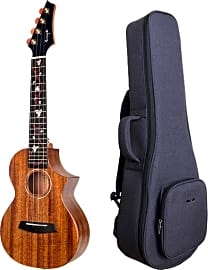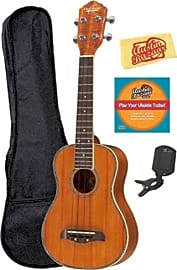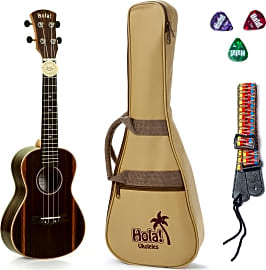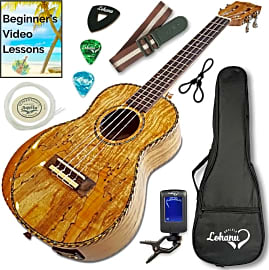The 10 Best Ukuleles

This wiki has been updated 39 times since it was first published in September of 2015. If you're into tiptoeing through the tulips, you may fancy trying your hand at one of these ukuleles, which produce the classic sound that reminds us all of Hawaii. Now that this instrument has become almost mainstream, more and more people want to give it a whirl, so we've included models priced ideally for beginners through to instruments good enough for concert performances. When users buy our independently chosen editorial selections, we may earn commissions to help fund the Wiki.
Editor's Notes
November 26, 2020:
When purchasing a new ukulele, the main things you need to consider are its size, what material it's made from, and whether or not you need to amplify it (for gigs, for example). This list has models in all three of the standard soprano, concert, and tenor sizes, but not the larger baritone and bass versions as these are rarer types that use a different tuning not commonly associated with ukulele playing. We have ranked both acoustic and electro-acoustic models, with most made from hardwood like mahogany for a warm, full sound.
We kept the Mahalo Ukuleles Rainbow Series as the budget option, removing the similarly-priced Hamano U-30 in favor of better quality high-end models such as the Cordoba 15SM, with its long fretboard and ornate decorations, and the Enya EUC-M6, a seriously good-looking uke with a horned cutaway and inline headstock.
The list now features five bundle kits to get new players started with everything they need. We kept the Hricane Concert and the Hola! Music Deluxe for those in need of a more budget-friendly price point, and added the Kala KA-CE Bundle and the Lohanu LU-MAGE-T to the Oscar Schmidt OU5 Bundle so that those who are serious about learning (and don't want to outgrow their instruments in a few years' time) have a wide range of options to choose from.
The futuristic Lava U is like no other uke we've seen, with a carbon fiber body that won't expand or contract in humid or cold climes, and three effects that can be added to your sound without amplification (although the instrument is, of course, fitted with a pickup and jack if you do need to be plugged in). The "space-case" fits this concept ukulele to a T, it's just a pity they force you to buy their special strap at an extra cost, as it's the only one that will fit.
November 25, 2019:
We wanted this list to showcase some of the best tenor, concert, bass, and soprano ukes out there, with acoustic and electric options, as well as instruments ideal for beginners, children, and serious enthusiasts.
We said goodbye to the Trendy Traditional Economy due to availability issues and replaced it with the Hricane Concert, an excellent, high-quality model with meticulous construction that's great for beginners and comes with everything you need to get started. We also scrapped the Diamond Head DU-150, which is a solid budget option, however, we wanted to add another high-end model in the form of the Ibanez UEW15E.
The Luna Great Wave is a beautifully made instrument with exceptional details and graphics, which makes it perfect for the performer who wants to play in front of people. If you're looking to introduce a youngster to the uke, then you can't go wrong with the Mahalo Ukuleles Rainbow Series and Kala Learn To Play Starter Kit, while the Kala Rumbler U-Bass is a unique choice for anyone who wants to stand out from the crowd.
Special Honors
Smart Ukulele You can learn how to strum your favorite songs in no time thanks to this European maple ukulele and its smart technology. With Bluetooth connectivity and a corresponding app, you can choose the chords or full songs you'd like to play and follow along on the light-up fretboard. If you're just beginning, this is ideal for picking up music quickly, as it provides a mental image of how chords look. You can also record your songs and share them with friends and family via the app. uncommongoods.com
Alvarez Regent RU22C Concert Ukulele The Alvarez Regent RU22C is a carefully designed, responsive instrument that provides an open sound with good projection, volume, and a fine tone. It's constructed with a dovetail neck joint for optimal strength and transfer of energy, and the bracing design is a modification on traditional fan-style braces to optimize response. It also boasts a rosewood fingerboard, real bone nut and saddles, and premium tuners. alvarezguitars.com
A Break From The Mundane
The tenor has an even deeper tone and louder volume than either the concert or soprano ukuleles.
Every musical instrument has a unique sound that transcends the boundaries of time. Instruments are introduced, they gain popularity, lose popularity, only to experience a revival again through the passage of time and among the nature of human evolution. Musical compositions are also part of this cycle, given that their very nature allows them to be played over and over. For that reason, music evokes the emotions and memories.
Certain instruments also evoke associations with a place or context. What does this mean? Take the saxophone as an example. A saxophone is a symbol of the jazz genre, which makes one think of places like New Orleans, loud clubs, speakeasies, and prohibition. Now, consider another instrument like the ukulele and ask yourself to list some of the images and context that it evokes.
Perhaps the Hawaiian Islands and other Polynesian islands of the Pacific Ocean come to mind along with lazy days on the beach and just an overall difference from normal everyday living. Each instrument carries with it a cultural imprint that forms its reputation, which makes it an evolving art form. The ukulele is no exception.
The ukulele (abbreviated as uke) is identified as a member of the lute family of instruments, made up of four gut strings that run parallel to its main body. Sometimes, these strings are made in courses, which gives the instrument closer to six or eight total strings designed to help improve the strumming volume. The strings are commonly made from nylon polymer. Ukuleles typically have a figure-eight shape resembling a small guitar or cello, but they can also be made in other shapes (i.e. ovals and squares).
The traditional ukulele is made from the wood of an Acacia koa tree. The more pricey ukuleles are made from pure hardwoods like mahogany, while less expensive ones are constructed from a combination of plywood, plastics, or laminate woods. The instrument's tone is reminiscent of a banjo-like, plucky sound that lends itself well to strumming cords with one's thumb.
There are four common sizes of ukulele to choose from: concert, soprano, tenor, and baritone. Less commonly used are the bass and contrabass ukuleles. The soprano is considered the second smallest of all four and is known as the standard version in Hawaii. The concert size is slightly larger than the soprano with a deeper and louder tone. The tenor has an even deeper tone and louder volume than either the concert or soprano ukuleles. The baritone resembles a small tenor guitar, while the bass and contrabass are the most recently developed of the ukulele family.
Hybrid History
While it's not considered a native instrument, that doesn't mean the ukulele's history is any less interesting. It isn't derived from a single parent instrument, rather, it is considered a hybrid (or a cross) between several guitar-like instruments, including the Portuguese machete and five-string rajão dating back to the eighteenth century. These instruments were originally imported into Hawaii by Portuguese immigrants from both Madeira and Cabo Verde (Cape Verde) through the nineteenth century.
By the late 1930s, the ukulele had lost some of its popularity to the electric guitar, partially due to a surge in upcoming jazz musicians.
The three immigrants credited as the first ukulele inventors were Madeiran cabinet makers Manuel Nunes, José do Espírito Santo, and Augusto Dias who all arrived on the Hawaiian shores from Portugal on a ship called the Ravenscrag in 1879. Along with four hundred other immigrants aboard the ship, the three cabinet makers came to work the sugar cane fields. However, once the trio's contracts were up for the sugar cane fields, they began building ukuleles for themselves and friends. The instrument was to become very popular among the Hawaiian natives. The ukulele was also displayed at the World’s Columbian Exposition in Chicago in 1893.
Espirito Santo was the first to advertise the instrument in 1898, but it wasn't until the 1915 Panama-Pacific International Exposition in San Francisco that the ukulele's popularity exploded in the United States.
Manuel Nunes and family opened a production factory in 1910, which continued assembling ukuleles until the 1930s. By the late 1930s, the ukulele had lost some of its popularity to the electric guitar, partially due to a surge in upcoming jazz musicians.
Ukulele popularity remained low until the 1990s when the internet was able to bring instrument makers and players together to share experiences and music. This spawned a new digital subculture for the instrument, which is still going strong today.
Strumming On The Old Ukulele
Because the ukulele sound is so unique, the deeper and richer it becomes, the easier it is to hear. For that reason, an instrument made from high-quality materials with thick, durable strings can make all the difference. Additionally, the instrument should be relatively easy to tune, regardless of whether you choose to use the standard or electronic tuning method.
For that reason, an instrument made from high-quality materials with thick, durable strings can make all the difference.
If you consider yourself a beginner with a strong interest in learning how to play the instrument, then sturdy plastic or laminate wood construction is often a great choice to start with, especially if you plan to travel with the instrument, you require something tough and able to withstand some abuse, or are planning to purchase an instrument for your child.
You don't need to break the bank to buy an ukulele, there are many inexpensive models for beginners that still produce a decent tone. Plastic ukuleles also come in many different colors. Once you've got some experience with the instrument, then consider a more expensive model made from natural woods.
One must also determine the size of ukulele they'd like to play. Don't let all the available sizes deter or overwhelm you from making a choice. A local music store can be a big help in this regard. Store employees can introduce you to the different sizes, what they sound like, and how best to tune them.















